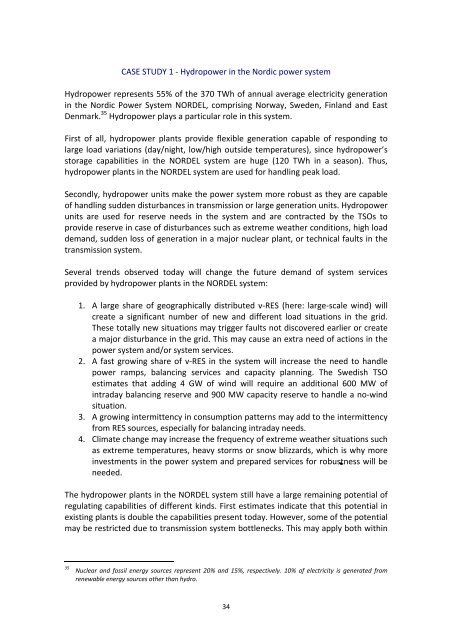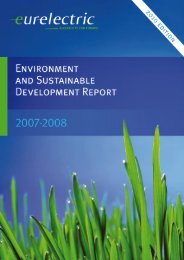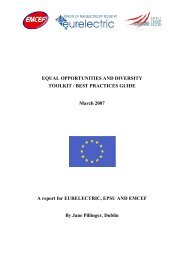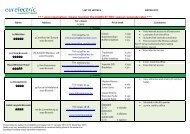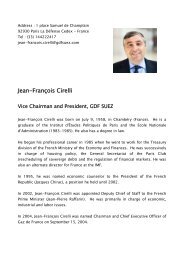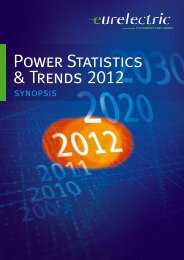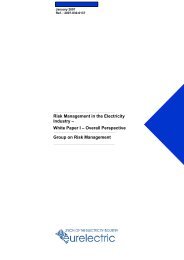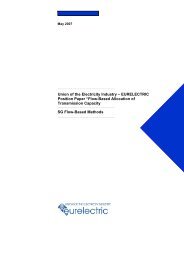Hydro in Europe: Powering Renewables - Full Report - Eurelectric
Hydro in Europe: Powering Renewables - Full Report - Eurelectric
Hydro in Europe: Powering Renewables - Full Report - Eurelectric
You also want an ePaper? Increase the reach of your titles
YUMPU automatically turns print PDFs into web optimized ePapers that Google loves.
CASE STUDY 1 - <strong>Hydro</strong>power <strong>in</strong> the Nordic power system<br />
<strong>Hydro</strong>power represents 55% of the 370 TWh of annual average electricity generation<br />
<strong>in</strong> the Nordic Power System NORDEL, compris<strong>in</strong>g Norway, Sweden, F<strong>in</strong>land and East<br />
Denmark. 35 <strong>Hydro</strong>power plays a particular role <strong>in</strong> this system.<br />
First of all, hydropower plants provide flexible generation capable of respond<strong>in</strong>g to<br />
large load variations (day/night, low/high outside temperatures), s<strong>in</strong>ce hydropower’s<br />
storage capabilities <strong>in</strong> the NORDEL system are huge (120 TWh <strong>in</strong> a season). Thus,<br />
hydropower plants <strong>in</strong> the NORDEL system are used for handl<strong>in</strong>g peak load.<br />
Secondly, hydropower units make the power system more robust as they are capable<br />
of handl<strong>in</strong>g sudden disturbances <strong>in</strong> transmission or large generation units. <strong>Hydro</strong>power<br />
units are used for reserve needs <strong>in</strong> the system and are contracted by the TSOs to<br />
provide reserve <strong>in</strong> case of disturbances such as extreme weather conditions, high load<br />
demand, sudden loss of generation <strong>in</strong> a major nuclear plant, or technical faults <strong>in</strong> the<br />
transmission system.<br />
Several trends observed today will change the future demand of system services<br />
provided by hydropower plants <strong>in</strong> the NORDEL system:<br />
1. A large share of geographically distributed v-RES (here: large-scale w<strong>in</strong>d) will<br />
create a significant number of new and different load situations <strong>in</strong> the grid.<br />
These totally new situations may trigger faults not discovered earlier or create<br />
a major disturbance <strong>in</strong> the grid. This may cause an extra need of actions <strong>in</strong> the<br />
power system and/or system services.<br />
2. A fast grow<strong>in</strong>g share of v-RES <strong>in</strong> the system will <strong>in</strong>crease the need to handle<br />
power ramps, balanc<strong>in</strong>g services and capacity plann<strong>in</strong>g. The Swedish TSO<br />
estimates that add<strong>in</strong>g 4 GW of w<strong>in</strong>d will require an additional 600 MW of<br />
<strong>in</strong>traday balanc<strong>in</strong>g reserve and 900 MW capacity reserve to handle a no-w<strong>in</strong>d<br />
situation.<br />
3. A grow<strong>in</strong>g <strong>in</strong>termittency <strong>in</strong> consumption patterns may add to the <strong>in</strong>termittency<br />
from RES sources, especially for balanc<strong>in</strong>g <strong>in</strong>traday needs.<br />
4. Climate change may <strong>in</strong>crease the frequency of extreme weather situations such<br />
as extreme temperatures, heavy storms or snow blizzards, which is why more<br />
<strong>in</strong>vestments <strong>in</strong> the power system and prepared services for robustness will be<br />
needed.<br />
The hydropower plants <strong>in</strong> the NORDEL system still have a large rema<strong>in</strong><strong>in</strong>g potential of<br />
regulat<strong>in</strong>g capabilities of different k<strong>in</strong>ds. First estimates <strong>in</strong>dicate that this potential <strong>in</strong><br />
exist<strong>in</strong>g plants is double the capabilities present today. However, some of the potential<br />
may be restricted due to transmission system bottlenecks. This may apply both with<strong>in</strong><br />
35<br />
Nuclear and fossil energy sources represent 20% and 15%, respectively. 10% of electricity is generated from<br />
renewable energy sources other than hydro.<br />
34


